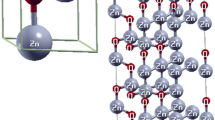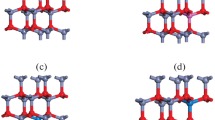Abstract
In this study First Principles calculations were carried out in order to analyze the effects of Ho-doping rate on the electronic and optical properties of ZnO films. The band structure, optical properties and density of states of Ho-doped ZnO with the doping rates of 0%, 1.38%, 1.85%, 2.78%, 4.17%, 6.25%, 12.5% and 25% were calculated and compared with our previous experimental results. XRD graphs showed that the Ho-doped ZnO had hexagonal structure with (101) preferential orientation. The optical band gap value for undoped ZnO firstly decreases to 3.055 eV for 1.38% Ho content, then starts to increase to the values of 3.109 eV and 3.177 eV for 1.85% and 2.77% Ho-ratios. Band gap decreases to 2.999 eV with 4% Ho-doping ratio again like the decrease in 1.38% Ho-content. Its observed that bandgap decreases with the decrease in a and b supercell parameters, the bandgap increases with the decrease on c supercell parameter, to verify that the %6.25, %12.5 and %25 doping rates are also studied and the bandgap kept increasing to 3.071 eV for %6.25 Ho-doping rate, 3.147 eV for %12.5 Ho-doping rate. The last calculation for %25 Ho-doping rate showed that the bandgap decreased to 2.727 eV. The optical calculations revealed that Ho-doping leds to blue shift and red shifts in optical absorption, transmittance, dielectric function, reflectivity, refractive index, extinction coefficient, optical conductivity, and loss function characterizations. Result shows that ZnO can be healed by Ho-doping and the calculations carried out by First principles are in a good harmony with experimental results.












Similar content being viewed by others
Data availability
All data generated or analyzed during this study are included in this published article
References
H.-I. Chen, J.-J. Hsiao, C.-H. Fang, J.-A. Jiang, J.-C. Wang, Y.-F. Wu, T.-E. Nee, J. Lumin 190, 136–140 (2017)
Z. Chun-Ying, W. Jing, B. Yue-Lei, Chin. Phys B 19, 047101 (2010)
L. Prasanna, V.R. Vijayaraghavan, Mater. Sci. Eng., C 77, 1027–1034 (2017)
A. Khayatiana, V. Asgaria, A. Ramazania, S.F. Akhtarianfar, M.A. Kashia, S. Safa, Mater. Res. Bull 94, 77–84 (2017)
Y. Chen, L. Wang, W. Wang, M. Cao, Mater. Chem. Phys 199, 416–423 (2017)
J. Ding, H. Chen, H. Fu, Mater. Res. Bull 95, 185–189 (2017)
E.V. Kolobkova, S.K. Evstropiev, N.V. Nikonorov, V.N. Vasilyev, K.S. Evstropyev, Opt. Mater 73, 712–717 (2017)
E.F. Keskenler, G. Turgut, S. Aydın, R. Dilber, U. Turgut, J. Ovo. Res. 9, 61–71 (2013)
A.G. El Hachimi, H. Zaari, A. Benyoussef, M. El Yadari, A. El Kenz, J. Rare Earths 32, 715 (2014)
S. Aydin, G. Turgut, Appl. Phys. A 9, 61–71 (2019)
S.J. Clark, M.D. Segall, C.J. Pickard, P.J. Hasnip, M.J. Probert, K. Refson, M.C. Payne, Z. für Kristallographie 220(5–6), 567–570 (2005)
Z. Ma, F. Ren, X. Ming, Y. Long, A. Volinsky, Materials 12, 196 (2018)
D.M. Song, J.C. Li, Comput. Mater. Sci. 65, 175–181 (2012)
S. Fan, Z. Liu, Z. Li, Polytech. Univ. 32, 114–117 (2013)
A. Jain, S.P. Ong, G. Hautier, W. Chen, W.D. Richards, S. Dacek, S. Cholia, D. Gunter, D. Skinner, G. Ceder, K.A. Persson, APL Mater 1, 011002 (2013)
J. Wen, J. Zhang, Z. Qiu, Phys. B Condens. Matter 534, 44–50 (2018)
S.Q. Guo, Q.-Y. Hou, C.-W. Zhao, F. Mao, Acta Phys. Sin 63, 107101 (2014)
M. Yu, S. Yang, C. Wu et al., Comput. Mater. 6, 180 (2020). https://doi.org/10.1038/s41524-020-00446-9
P.P. Pradyumnan, A. Paulson, M. Sabeer N. A. and N. Deepthy, AIP Conf. Proc. 1832, 110055 (2017)
A. Ekicibil, Solid State Sci 14, 1486–1491 (2012)
A. Khataee, S. Saadi, B. Vahid, S.W. Joo, J. Ind. Eng. Chem 35, 167–176 (2016)
B. Demirselcuk, V. Bilgin, Appl. Surf. Sci. 273, 478–483 (2013)
R.A. Mereu, A. Mesaros, M. Vasilescu, M. Popa, M.S. .Gabor, L. Ciontea, T.Petrisor Ceramics International 39, 5535–5543 (2013)
M. Leclerc, G. D’aprano, G. Zotti, Synth. Met. 55, 1527–1532 (1993). https://doi.org/10.1016/0379-6779(93)90279-6
Funding
Serdar AYDIN declares that no funds, grants, or other support were received during the preparation of this manuscript.
Author information
Authors and Affiliations
Contributions
SA is only the author who study conception and design. Material preparation, data collection and analysis were performed by SA. The manuscript was written and controlled by SA.
Corresponding author
Ethics declarations
Competing interest
Serdar AYDIN has no relevant financial or non-financial interests to disclose
Additional information
Publisher’s Note
Springer Nature remains neutral with regard to jurisdictional claims in published maps and institutional affiliations.
Rights and permissions
Springer Nature or its licensor (e.g. a society or other partner) holds exclusive rights to this article under a publishing agreement with the author(s) or other rightsholder(s); author self-archiving of the accepted manuscript version of this article is solely governed by the terms of such publishing agreement and applicable law.
About this article
Cite this article
Aydin, S. First principles calculations and analysis of electronic and optical structure of Ho-doped ZnO films. J Mater Sci: Mater Electron 34, 771 (2023). https://doi.org/10.1007/s10854-023-10168-5
Received:
Accepted:
Published:
DOI: https://doi.org/10.1007/s10854-023-10168-5




